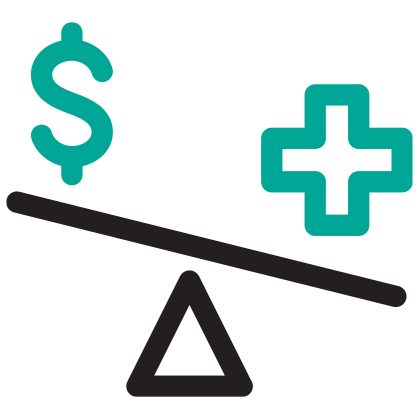 When radiologist Pamela Johnson first began leading the charge to advance “high-value” medical care, the concept was barely on the radar of many clinicians. Today, some four years later, she finds herself as a national leader on this issue as hospitals and health care systems have embraced the movement with urgency.
When radiologist Pamela Johnson first began leading the charge to advance “high-value” medical care, the concept was barely on the radar of many clinicians. Today, some four years later, she finds herself as a national leader on this issue as hospitals and health care systems have embraced the movement with urgency.
“It’s been an exciting ride,” says Johnson, who is co-chair of the Johns Hopkins Health System High Value Care Committee, and was recently named a Center for Innovative Medicine (CIM) Stanley Levenson Scholar.
So what exactly is high-value care? Within the world of health care, value is defined as the ratio of quality over price, just as with any consumer product. If, for example, you can get a great car for a cheap price, you have a high-value car. The U.S. health care system has been critiqued for its low value. Though Americans spend twice as much on health care as some other advanced countries, the resulting quality (i.e., health outcomes) is not better – and sometimes is worse.
And it is patients who are paying the price, says Johnson. As she points out in a recent paper published in Academic Medicine, medical debt is the leading contributor to U.S. personal bankruptcy, and patients are choosing to avoid necessary care because of its cost. “[This] is a call to action for the profession to transition to a high-value model – one that delivers the highest health care quality and safety at the lowest personal and financial cost to patients,” wrote Johnson.
In 2016, Johnson and Vice Dean for Education Roy Ziegelstein recognized the need to escalate the work nationally and believed that collaboration across medical centers could deliver large-scale improvements in value. With the assistance of Dean/CEO Paul Rothman, they established the High Value Practice Academic Alliance, an organization that now includes 100 academic partner institutions. In November, the alliance hosted its third national conference here in Baltimore, sponsored by the Johns Hopkins University School of Medicine.
Johnson points out that a leading cause of low-value care is unnecessary medical testing, including blood-work, MRI scans and CT scans. From the beginning of her work in this area, she has championed the importance of engaging medical students and residents in the research and performance improvement necessary to ensure that potentially unnecessary tests can be safely reduced in practice. Toward that end, in 2015, she joined forces with Susan Peterson to create and co-direct the High Value Practice Alliance at Johns Hopkins.
Residency program directors from multiple specialties joined the committee to tackle problems that are largely multidisciplinary. “I’m a radiologist, but if I observe areas where patients are not benefiting from imaging and want to reduce utilization, I can’t do it myself,” says Johnson. “It has to be a team effort.”
The work quickly advanced beyond the graduate medical education arena, she says, owing to the creation of the Johns Hopkins Health System High-Value Care Committee by Redonda Miller and Renee Demski in 2016, followed in 2018 by the appointment of a high-value faculty lead in each department at The Johns Hopkins Hospital. Johnson has subsequently observed systemwide growth of these types of initiatives.
“[This] is a call to action for the profession to transition to a high-value model – one that delivers the highest health care quality and safety at the lowest personal and financial cost to patients.”
She points to Agile MD as one example of an important tool that started as the brainchild of Johns Hopkins Hospital Emergency Department providers and will soon be improving care across the Johns Hopkins Health System. An evidence-based decision support tool, Agile MD works within the Epic electronic medical record system to place relevant best-practice guidance and information within easy reach of clinicians as they make decisions about testing and treatment. The content is created by Johns Hopkins physicians, advanced practice providers, nurses, pharmacists and residents, who synthesize the literature with their own clinical experience.
“We want clinicians to make decisions according to the evidence in a way that is at the same time tailored to the patient and their clinical acumen,” says Johnson. “We don’t want to completely standardize care, but we do want to reduce variability that does not improve outcomes, especially when it involves overuse or underuse of tests and treatments.”
Johnson’s tireless leadership in high-value care aligns beautifully with the mission of the Center for Innovative Medicine, says Hellmann. “An important part of pursuing medicine as a public trust involves being good stewards of society’s resources,” he says. “The CIM is very proud of Dr. Pam Johnson’s efforts to get all of us higher quality for less cost.”
For her part, Johnson says, “Being named the CIM Levenson Scholar is the greatest honor of my medical career.” The funding, she says, “will enable me to escalate our effectiveness and deliver measurable improvements in health care quality and affordability at Johns Hopkins and across the country. Of equal importance, by demonstrating accountability for the improvements that we need to make within health systems, we will safeguard patients’ trust in physicians and medical institutions.”